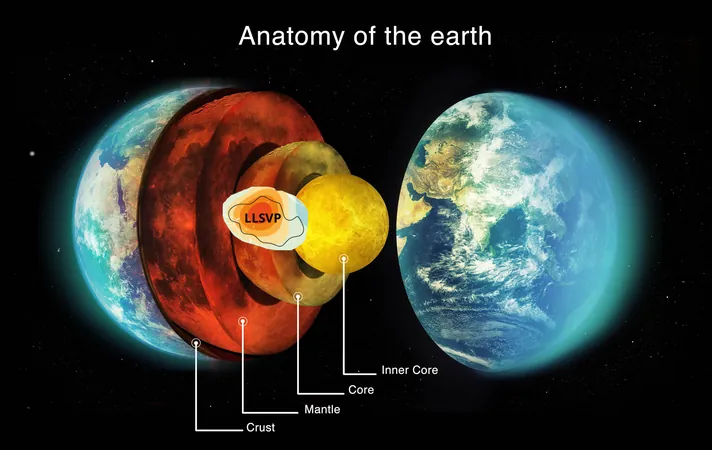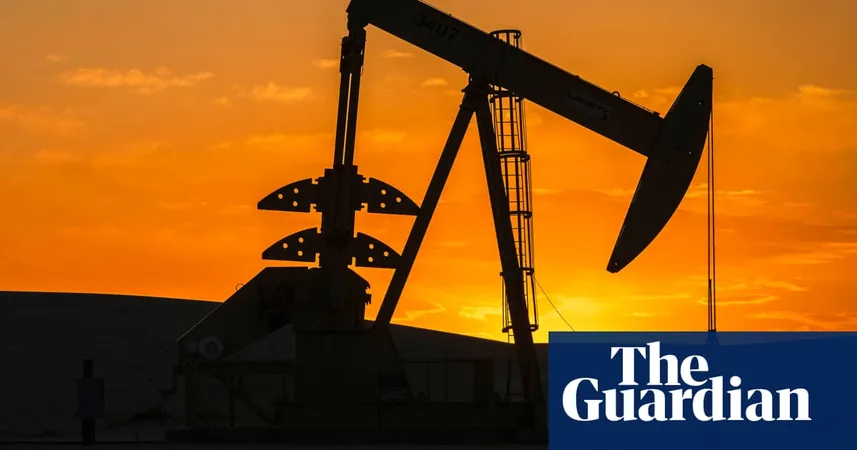
Mind-Blowing Discovery: Earth's 'Islands' Tower 100 Times Higher Than Everest!
2025-01-24
Author: Ting
Introduction
Scientists have made an astonishing revelation: two massive, continent-sized regions, dubbed "islands," are lurking deep within the Earth’s mantle. Research conducted by Utrecht University indicates these structures, which lie about 1,200 miles (2,000 kilometers) beneath the surface, are not only significantly hotter than the surrounding mantle, but date back more than half a billion years, suggesting they are remnants of a distant geological past.
The existence of these hidden regions raises questions about the long-accepted notion that the Earth's mantle is a well-mixed and dynamic environment. Instead, the latest findings imply that the mantle has much less horizontal flow than previously thought, indicating a more complex internal structure.
These geological giants, reaching heights of approximately 620 miles (1,000 kilometers), dwarf even the tallest mountains on Earth, including Mount Everest. The locations of these underground islands have been traced beneath Africa and the Pacific Ocean, with their existence first hinted at in the late 20th century through advanced seismic analysis techniques.
What Are These Mysterious Low Seismic Velocity Provinces?
Known as Large Low Seismic Velocity Provinces (LLSVPs), these formations significantly slow down seismic waves due to their elevated temperatures. When earthquakes occur, the Earth resonates similarly to a bell, providing scientists with valuable data about these enigmatic subsurface anomalies.
Arwen Deuss, the lead author of this groundbreaking study, emphasizes the mystery surrounding these regions: "Nobody knows what they are, and whether they are only a temporary phenomenon or if they have been sitting there for millions or even billions of years.”
Temperatures, Damping, and Grain Size: The Scientific Puzzle Solved
The team employed a novel method that measured not only how much the seismic waves slowed down but also how much energy they lost as they moved. Surprisingly, the LLSVPs showed very little damping, creating a clearer sound profile, while the cooler surrounding areas demonstrated significant energy loss.
Delving deeper into the properties of these regions, co-author Laura Cobden suggests that grain size plays a critical role in this phenomenon. The surrounding tectonic plates, which are recycled in the mantle, tend to recrystallize into smaller grains leading to notable energy dissipation. In contrast, the LLSVPs appear to contain larger mineral grains, which facilitate the faster passage of seismic waves.
Research indicates that since the mineral grains within these islands grow very slowly, this contributes to their ancient nature. The study proposes that the LLSVPs might not partake in the convection processes that drive the surrounding mantle movement and have remained largely unchanged for extensive periods.
Why Understanding These 'Islands' Matters
The rigid characteristics and age of the LLSVPs compel scientists to reassess the conceptualization of the mantle. Talavera-Soza notes, "After all, the LLSVPs must be able to survive mantle convection one way or another." This revelation has far-reaching implications regarding Earth’s geological evolution and the forces driving surface activity, including volcanism and orogeny (mountain building).
Mantle plumes—columns of hot material emanating from the mantle—are believed to originate at the edges of these islands, ultimately unleashing volcanic eruptions, as seen in locations like Hawaii.
To further explore these deep-seated mysteries, seismologists analyze the energetic echoes from significant earthquakes, such as the Bolivia quake of 1994, which went unreported as it occurred at a depth of 650 kilometers with no surface impact.
Concluding Thoughts: A New Era in Earth Science
This significant research reshapes our understanding of the Earth’s mantle. Instead of a homogenous and dynamic environment, scientists are uncovering the presence of ancient, stable structures that challenge conventional models. Understanding these regions is crucial in interpreting geological processes and unlocking the complex events that have sculpted our planet over eons.
The groundbreaking findings have been published in the journal *Nature*, marking a pivotal moment in the study of Earth's mesmerizing and intricate inner workings. Stay tuned for more revelations about the hidden forces that shape our world!


 Brasil (PT)
Brasil (PT)
 Canada (EN)
Canada (EN)
 Chile (ES)
Chile (ES)
 Česko (CS)
Česko (CS)
 대한민국 (KO)
대한민국 (KO)
 España (ES)
España (ES)
 France (FR)
France (FR)
 Hong Kong (EN)
Hong Kong (EN)
 Italia (IT)
Italia (IT)
 日本 (JA)
日本 (JA)
 Magyarország (HU)
Magyarország (HU)
 Norge (NO)
Norge (NO)
 Polska (PL)
Polska (PL)
 Schweiz (DE)
Schweiz (DE)
 Singapore (EN)
Singapore (EN)
 Sverige (SV)
Sverige (SV)
 Suomi (FI)
Suomi (FI)
 Türkiye (TR)
Türkiye (TR)
 الإمارات العربية المتحدة (AR)
الإمارات العربية المتحدة (AR)